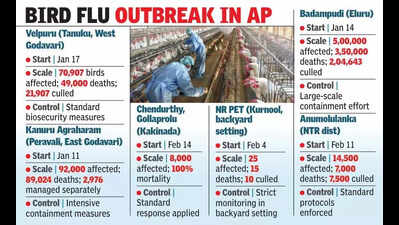Visakhapatnam: An analysis of the specimen from the recent fatal bird flu case in Palnadu district by the National Institute of Virology in Pune has revealed that the two-year-old girl, who succumbed to H5N1 infection, was infected with the clade 2.3.2.1a strain.
The investigation further clustered the case with a 2024 travel-associated case from West Bengal. The death of the two-year-old girl from Narasaraopet was the second human death from H5N1 bird flu virus in India.
Notably, India’s first bird flu death in Haryana in 2021 was also linked to the same hemagglutinin gene clade, 2.3.2.1a, where a young boy fell victim to the illness. The observed clustering in the Palnadu case indicates that migratory wild birds or other cross-border transmission routes may be facilitating the spread of this lineage, highlighting an intricate network of viral evolution in the region.
NIV-Pune has shared details of the Palnadu case with GISAID (Global Initiative on Sharing All Influenza Data), which monitors influenza virus evolution, transmission patterns, and genomic surveillance worldwide.
Including the Palnadu case, India has so far reported a total of five human avian influenza cases involving H5N1 and H9N2. These include one case from Maharashtra in June 2019, one from Haryana in July 2021, and two from West Bengal in April and May 2024. In Andhra Pradesh, the recent infection marks the state’s first human bird flu case and death.
According to the phylogenetic tree dataset available on GISAID — which compiles genetic sequence records from influenza virus samples collected across various countries and hosts — the clustering observed in the Palnadu case strongly suggests cross-border or migratory bird transmission. The dataset features sequences from diverse geographical locations such as Bangladesh, Cambodia, Vietnam, and Australia, reinforcing concerns about the global movement of the virus.
For instance, several entries in the dataset from domestic avian hosts such as ducks and chickens appear alongside isolates from wild birds, crows, and even non-avian hosts like tigers. This variety in host species not only points to the adaptability of the virus but also elevates its potential for interspecies transmission, posing an increased zoonotic risk not just in Andhra Pradesh, but nationwide.
According to GISAID, limited surveillance of this lineage in India underscores the urgent need for expanded monitoring in poultry and wild birds to assess its spread, evolution, and zoonotic risk. Andhra Pradesh has recorded eight outbreaks of bird flu across the state in 2025, affecting more than 5.4 lakh birds and leaving 6.02 lakh birds susceptible. These outbreaks, which occurred in regions ranging from West Godavari, East Godavari, and Krishna in coastal Andhra Pradesh to Kurnool in Rayalaseema, took place in both large-scale commercial farms and small backyard settings.
While some outbreaks began in mid-January, others were not detected until mid-February. According to experts, this staggered chronology suggests that the virus possibly spread from an initial focal point before seeding new areas through bird movement or lapses in biosecurity, highlighting significant challenges in controlling avian influenza outbreaks.






